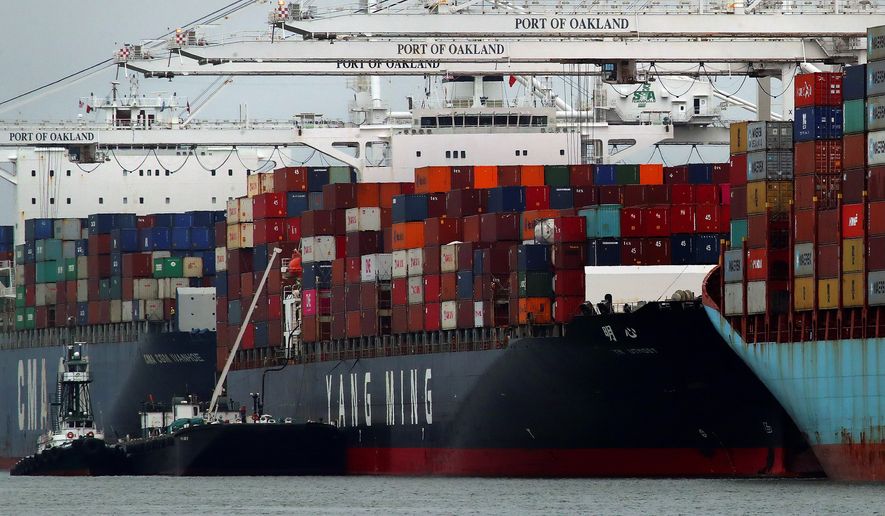
Photo by: Ben Margot
The Yang Ming shipping line container ship Ym Utmost is unloaded at the Port of Oakland on Monday, July 2, 2018, in Oakland, Calif. The Trump administration on Friday, July 6, 2018, will start imposing tariffs on $34 billion in Chinese imports. (AP Photo/Ben Margot)
BEIJING — Since the 2009 global financial crisis hobbled most of the world’s developed countries, China has been the economic locomotive pulling the rest of the world behind it.
As the economies of Europe, the U.S. and Japan stagnated, China went from strength to strength. It surpassed its Asian rival to the east a decade ago in total gross domestic product to become the world’s second-largest economy, with its sights trained squarely on the United States.
Indeed, judged by what economists call purchasing power parity — the idea that services such as a haircut are valued equally — Beijing already can claim the title of the world’s largest economy.
But the sputtering Chinese-driven train appears to have pulled into the station. Growth targets have been slashed. Exports have fallen. Debt levels are rising. Some economists even say China is in a recession.
“It is true that China’s economy has encountered new, downward pressure,” Chinese Premier Li Keqiang told reporters last week at the conclusion of the annual National People’s Congress gathering in Beijing. Faced with growing pressures within and without, the government said it plans to create more than 11 million jobs this year to avoid a politically disruptive slowdown.
Mr. Li used unusually stark language to describe the challenges China faces. He said government planners at all levels need to “turn the blade inward” and “cut our own wrists” to carry out the sacrifices needed to keep the economy afloat.
In the long-run competition between the U.S. and China for economic supremacy, JP Morgan Chase CEO Jamie Dimon said he is betting on the U.S.
“It isn’t like the Chinese have a free ride for the next 20 or 30 years,” Mr. Dimon said in an interview this week with CNN.
A recent visit to China reveals how a confluence of factors — not least the Trump administration’s trade war and demands for deep changes in the way the Asian giant does business — has put the nation’s economic model, so successful over the past 40 years, in real peril.
The ‘world’s factory’
In 1978, Deng Xiaoping and his fellow reformers in the ruling Communist Party inherited an economy — and society — all but ruined by Mao Zedong.
In the 19th century, China was one of the world’s richest, most productive economies. But by the end of Mao’s disastrous 27-year reign of collectivization, state command and brutality, the country was deeply impoverished, barely able to feed itself. During the grim, ironically named Great Leap Forward, a period of mass collectivization that lasted from 1958 to 1962, tens of millions died of starvation as China’s agricultural sector was devastated.
Deng commenced China’s “reform and opening-up,” a shift still widely celebrated in China — a bright red sign flying in Tiananmen Square marks the recent 40th anniversary of the inauguration of the policy. While retaining strict political control, Deng legalized entrepreneurship and liberated the peasants who had been forced onto Mao’s collectivized farms. Perhaps most crucial, Deng permitted foreign investment, though only as part of joint ventures with Chinese companies.
It was that last decision that many credit with providing the underpinning for the wildly successful Chinese development model of the subsequent four decades. Foreign investors found China to be an enticing manufacturing base, boasting a massive workforce willing to work for pennies on the dollar.
Factory investment surged along with exports. Chinese exports, produced for a fraction of the cost of goods produced in other countries, were able to compete on price if not quality. China’s 2001 entry into the World Trade Organization only served to further China’s emergence as the world’s factory floor, signaling profound disruptions in the economies across Asia, Europe and the Americas.
Meanwhile, the Chinese government recirculated the cash it vacuumed up from overseas exports into investment. During the 2009 financial crisis, Beijing’s leaders had the firepower to unleash a massive construction boom that kept the economy humming even as much of the world fell into a recession.
The United States, as the world’s largest consuming nation, has been a particularly attractive target for Chinese exports. In 2006, the U.S. imported $343 billion worth of Chinese products. By 2017, that number had leaped to $522.9 billion, according to U.S. government data.
China was steadily moving up the supply chain.
No longer just the world leader in producing cheap plastic junk, China had top exports in 2017 that included mobile phones, computers, computer parts and integrated circuits. U.S. exports to China that year amounted to a mere $187.5 billion, resulting in a $335.4 billion trade gap.
It is this severe trade imbalance that President Trump has sought to redress by imposing tariffs on scores of Chinese exports — so far targeting about $250 billion worth of Chinese imports — hitting various sectors such as solar panels, washing machines and dental fillings.
The tariffs serve two purposes for the economic nationalist president. For one, they encourage manufacturers to set up shop in the U.S. by undercutting China’s competitive cost advantage.
U.S. officials say the tariffs have been useful for pressuring Beijing to change its behavior on other fronts, including North Korea, intellectual property theft, forced technology transfers and myriad other restrictions on foreign companies operating in China. Chinese companies operating in the U.S. market are not subject to such restrictions.
Despite widespread skepticism among economists that Mr. Trump’s tariffs are simply taxes on American consumers, there is strong evidence that they have had some success in hobbling the Chinese export-oriented development model.
Gordon Chang, a longtime China watcher and author of “The Coming Collapse of China,” said Chinese exporters are absorbing more than 80 percent of the costs of U.S. tariffs related to intellectual property theft and forced technology transfers.
“It makes sense that desperate Chinese exporters are willing to pay a good portion of the tariffs to preserve market share,” Mr. Chang said.
But even as Chinese economic officials try to stave off the effects of the U.S. tariffs, exports have swooned. Chinese exports to the United States were down 14.1 percent in the first two months of 2019 compared with the previous year. The falloff has dragged down the Chinese economy as a whole.
The trade dispute has “negatively impacted consumer confidence,” said Jake Parker of the U.S.-China Business Council in Beijing.
Target shooting
For years, the Chinese economy was essentially the world’s most successful target shooter.
Each year, the central government would set a “target” for GDP growth. And each year, like clockwork, the economy would hit the bull’s-eye — or so the official data said. In the heady three decades after Deng’s reforms took hold, GDP growth routinely topped 10 percent. Even since 2010, the target range was still a lofty 8 percent while U.S. annual growth never topped 3 percent.
But this year, the government has set a target of just 6 percent GDP growth, which is evidence of a stark slowdown.
Even the 6 percent growth may be a mirage, whatever the official numbers show.
Tony Nash, managing partner at economic forecasting firm Complete Intelligence with deep experience in China, called the Beijing government’s official figures “a Potemkin village, simply presented for the impression.”
“This is done because the expectations of 8 percent growth, for example, was set more than a decade ago in order to create enough jobs for the workforce,” he said. “That’s a high bar to achieve, but it’s also a higher expectation to overcome.”
Michael Pettis, a finance professor at Peking University, said he estimated that Chinese real GDP growth is only about half of what official figures indicate.
In Baoding, an industrial city about 100 miles southwest of Beijing, an industrial park manufacturing solar panels continues to operate despite the financial woes of Yingli Solar, one of the world’s biggest panel manufacturers. (Solar panels are targeted by Mr. Trump’s tariffs.)
In the midst of a major debt restructuring, Yingli is likely now serving only the domestic market and thus would be hit by any reduction in domestic investment. The company declined to speak to the media.
Still, like many other Chinese cities, Baoding has the appearance of a boomtown regardless of the underlying health of the economy. Cranes are everywhere. Glistening new malls stacked with Western stores are packed with shoppers.
Foreign firms continue to chase China’s vast consumer market. Pan Chenyin, China manager at Fireworks, a digital technology company that helps promote consumer brands, observed that “with the growing of the middle class, domestic consumer consumption is taking up a considerable amount of China’s economy.”
Despite the U.S.-China trade hostilities, he said, “I feel the spirit is high.”
Mr. Pan reports that leading consumer brands continue to increase their spending in China and that his firm is seeing 20 percent year-on-year growth — even in the midst of the slowdown.
Consumer focus
That is encouraging news for China’s economic planners, who are hoping to use the export slowdown to achieve their long-held goal of turning the country into more of a consumer-driven economy that is less dependent on exports and investments. Particularly with exports in trouble, China is “dependent on increasing investment for growth,” Peking University’s Mr. Pettis said. But the heavy influence of the government on the economy continues to hold China back.
“Because so much of that investment is ‘wasted’ on nonproductive or unnecessary infrastructure and real estate projects, and on excess capacity … debt is rising so much faster than their ability to service the debt.”
To get consumers to buy more, the Chinese government recently cut the national sales tax. But there is much more it could do, Mr. Pettis said. He suggested that local governments “lower fees for residents, for example car licenses, electricity, water … or lower costs for public transportation” to spur consumption.
One looming thundercloud is the possibility that Mr. Trump will increase tariffs. That would hurt exports further and depress consumer confidence.
Heated trade talks between China and the United States continue. Treasury Secretary Steven T. Mnuchin and U.S. Trade Representative Robert Lighthizer reportedly are planning another trip to Beijing next week. Mr. Trump has already delayed further tariffs once, but there is a clear concern that the mercurial American president is growing impatient.
Not long ago, there was a sense that Mr. Trump, operating in a slapdash manner and desperate for any form of “win,” would capitulate on the thorniest issues, including technology transfers and intellectual property protections. One official, who spoke in an unofficial and anonymous capacity, was gleeful in predicting that China would stare down the U.S. president and win.
But Mr. Trump’s abrupt exit from the Hanoi talks with North Korean leader Kim Jong-un has shaken that confidence and demonstrated, in fact, that Mr. Trump is willing to walk away from a deal that doesn’t suit him.
Still, the Chinese are putting on a brave face and predicting that the two sides will eventually cut a deal. At the same time, they are sounding a more conciliatory note than they did before the Hanoi summit.
Shen Dingli, a professor at Fudan University, is typically a reliable voice of the Chinese establishment and is known for his hawkish take on Chinese economic relations with Washington. These days, Mr. Shen sounds downright dovish. He is forecasting a “win-win, no-losers outcome” to Mr. Trump’s trade offensive.
“The U.S. will get more and better access to Chinese markets with more equal treatment of competition of export as well as investment,” he said, while “China will be able to maintain its current exports and even increase its exports.”
Source: https://www.washingtontimes.com/news/2019/mar/19/trump-trade-war-slows-china-economy-growth/
[Disclaimer]








